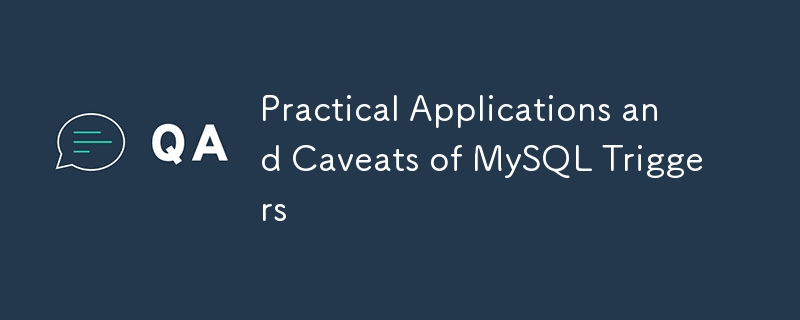Practical Applications and Caveats of MySQL Triggers
Jul 07, 2025 am 01:37 AMMySQL triggers can be used to automatically execute SQL statements to maintain data integrity, automate tasks, and implement business rules, but they need to be aware of their limitations. 1. Can be used for audit logs, data verification, derived field updates and cascading operations; 2. Not suitable for high-performance requirements, complex logic, hidden side effects scenarios; 3. Best practices include keeping concise, good documentation, avoiding circular dependencies, paying attention to trigger timing, adequate testing, and paying attention to the limitation of allowing only one trigger per table and event. Rational use can improve efficiency, but excessive dependence can lead to maintenance difficulties.

MySQL triggers are powerful tools that let you automatically execute SQL statements in response to specific events on a table, like inserts, updates, or deletes. They're useful for maintaining data integrity, automated tasks, and enforcing business rules — but they come with some gotchas.

What Can You Actually Use Triggers For?
Triggers shine when you need something to happen automatically based on changes in your database. Here are a few practical applications:

- Auditing and logging – Automatically record changes made to data into a separate log table.
- Data validation – Enforce constraints beyond what foreign keys can do, like checking if an updated value meets certain conditions.
- Derived fields – Update summary or computed values ??in real-time. For example, updating a user's total order amount whenever a new order is added.
- Cascading operations – Perform related actions across tables without needing application-level logic.
For instance, imagine you want to keep track of every time a user's email gets changed. A simple BEFORE UPDATE trigger can check if the email field has changed and log it into another table.
When Should You Not Use Triggers?
While triggers can simplify certain workflows, they're not always the best choice. Here are situations where you might want to avoid them:

- Performance-sensitive operations – Triggers add overhead to DML operations (like INSERT, UPDATE). If you're doing bulk imports or high-frequency writes, this can slow things down.
- Complex business logic – Managing complex logic in triggers can get messy and hard to debug. It's usually better handled in application code where you have more visibility and control.
- Unexpected side effects – Since triggers run behind the scenes, they can introduce behaviors that aren't immediately obvious to developers or DBAs. This makes troubleshooting harder.
Also, remember that triggers don't fire on bulk operations in some cases, depending on how the operation is structured — so be careful if you rely on them for large-scale changes.
Best Practices and Things to Watch Out For
If you're going to use triggers, here are a few tips to avoid common pitfalls:
- Keep them simple and focused. The more a trigger does, the harder it is to maintain.
- Document them well. Other developers may not expect a trigger to exist unless it's clearly noted.
- Avoid circular dependencies. For example, Trigger A updates Table B, which fires Trigger B that updates Table A again — this can lead to infinite loops or errors.
- Be cautious with
AFTERvsBEFOREtriggers. Depending on when you want the action to occur, mixing these up could cause unexpected results. - Test thoroughly. Especially with cascading effects, it's easy to miss edge cases during development.
One thing that often trips people up: MySQL allows only one trigger per event type per table. So if you try to create two BEFORE INSERT triggers on the same table, it won't work. You'll need to combine them into a single trigger body.
Trigger usage isn't complicated, but it's easy to overuse or misuse them. Used wisely, they can automatically repetitive tasks and help enforce consistency. But once they start getting too involved, it's usually better to move that logic elsewhere.
Basically that's it.
The above is the detailed content of Practical Applications and Caveats of MySQL Triggers. For more information, please follow other related articles on the PHP Chinese website!

Hot AI Tools

Undress AI Tool
Undress images for free

Undresser.AI Undress
AI-powered app for creating realistic nude photos

AI Clothes Remover
Online AI tool for removing clothes from photos.

Clothoff.io
AI clothes remover

Video Face Swap
Swap faces in any video effortlessly with our completely free AI face swap tool!

Hot Article

Hot Tools

Notepad++7.3.1
Easy-to-use and free code editor

SublimeText3 Chinese version
Chinese version, very easy to use

Zend Studio 13.0.1
Powerful PHP integrated development environment

Dreamweaver CS6
Visual web development tools

SublimeText3 Mac version
God-level code editing software (SublimeText3)

Hot Topics
 How to use parameters in MySQL triggers
Mar 16, 2024 pm 12:21 PM
How to use parameters in MySQL triggers
Mar 16, 2024 pm 12:21 PM
How to use parameters in MySQL triggers requires specific code examples. MySQL is a popular relational database management system that supports triggers to monitor changes in data in tables and perform corresponding operations. Triggers can be triggered when an INSERT, UPDATE or DELETE operation occurs. It is a powerful database function that can be used to implement data constraints, logging, data synchronization and other requirements. In MySQL, triggers can use parameters to pass data, and the parameters can be used to flexibly customize the trigger.
 MySQL's Place: Databases and Programming
Apr 13, 2025 am 12:18 AM
MySQL's Place: Databases and Programming
Apr 13, 2025 am 12:18 AM
MySQL's position in databases and programming is very important. It is an open source relational database management system that is widely used in various application scenarios. 1) MySQL provides efficient data storage, organization and retrieval functions, supporting Web, mobile and enterprise-level systems. 2) It uses a client-server architecture, supports multiple storage engines and index optimization. 3) Basic usages include creating tables and inserting data, and advanced usages involve multi-table JOINs and complex queries. 4) Frequently asked questions such as SQL syntax errors and performance issues can be debugged through the EXPLAIN command and slow query log. 5) Performance optimization methods include rational use of indexes, optimized query and use of caches. Best practices include using transactions and PreparedStatemen
 C++ Database Programming Guide: Best Practices for Interacting with Databases
Nov 27, 2023 am 09:11 AM
C++ Database Programming Guide: Best Practices for Interacting with Databases
Nov 27, 2023 am 09:11 AM
C++ Database Programming Guide: Best Practices for Interacting with Databases Summary: Databases are a vital component of enterprise applications, and C++ is a powerful and flexible programming language that can be used to develop high-performance database applications. . This article will introduce some best practices for interacting with databases, including tips and techniques for connections, queries, transactions, and data security. Introduction: A database is a tool for storing and managing large amounts of data. It provides a convenient and efficient way to access and manipulate data. Interact with the database
 Data triggering skills in MySQL
Jun 15, 2023 am 11:40 AM
Data triggering skills in MySQL
Jun 15, 2023 am 11:40 AM
MySQL is a widely used relational database management system that supports many different operations and functions. One of them is the data triggering technique, which can monitor and process data changes by defining triggers in the database. This article will introduce the basic principles, usage and examples of data triggering techniques in MySQL. 1. Basic principles of data triggers Data triggers in MySQL are a special type of stored procedures that can be defined and executed in the database. It is closely associated with the table. When a specified event (such as insert, update
 How to implement the statement to create a stored procedure in MySQL?
Nov 08, 2023 am 10:43 AM
How to implement the statement to create a stored procedure in MySQL?
Nov 08, 2023 am 10:43 AM
How to implement the statement to create a stored procedure in MySQL? MySQL is a commonly used relational database management system that provides a wealth of functions to manage and query data. Among them, stored procedures are an important database object that can help us encapsulate a series of SQL statements and logic for easy reuse and maintenance. This article will introduce how to create stored procedures in MySQL, while providing specific code examples. 1. The concept and advantages of stored procedures. A stored procedure is a predefined SQL that can be called.
 What are triggers in MySQL?
Apr 23, 2025 am 12:11 AM
What are triggers in MySQL?
Apr 23, 2025 am 12:11 AM
A MySQL trigger is an automatically executed stored procedure associated with a table that is used to perform a series of operations when a specific data operation is performed. 1) Trigger definition and function: used for data verification, logging, etc. 2) Working principle: It is divided into BEFORE and AFTER, and supports row-level triggering. 3) Example of use: Can be used to record salary changes or update inventory. 4) Debugging skills: Use SHOWTRIGGERS and SHOWCREATETRIGGER commands. 5) Performance optimization: Avoid complex operations, use indexes, and manage transactions.
 How to implement an online customer relationship management system in PHP?
May 11, 2023 pm 11:22 PM
How to implement an online customer relationship management system in PHP?
May 11, 2023 pm 11:22 PM
With the continuous development of the Internet, more and more companies are beginning to pay attention to the Online Customer Relationship Management System (OCRMS) in order to better manage customer relationships, improve customer satisfaction, and promote the long-term development of the company. As a powerful and widely used development language, PHP has also become one of the preferred languages ??for developing OCRMS. So, how to implement OCRMS in PHP?
 Configuring a Linux system to support database programming
Jul 05, 2023 pm 11:19 PM
Configuring a Linux system to support database programming
Jul 05, 2023 pm 11:19 PM
Configuring the Linux system to support database programming Due to the open source nature and stability of the Linux system, more and more developers choose to perform database programming in the Linux environment. In order to carry out database programming smoothly, we need to perform some configurations in the Linux system. First, we need to install the database server software. Common database software includes MySQL, PostgreSQL, Oracle, etc. In this article, we take MySQL as an example to explain in detail. Install MySQL data






